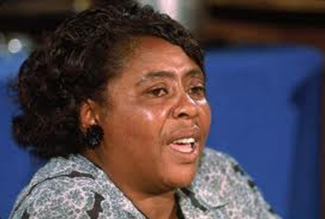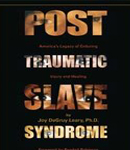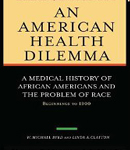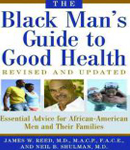|
A SERVICE OF HEALING (FOR THOSE SUFFERING EMOTIONAL DISTRESS,
GRIEF, DIVORCE, AND PHYSICAL AILMENTS)
CULTURAL RESOURCES
Sunday, August 4, 2013
Aisha K. Prim, Guest Lectionary Cultural Resource Commentator
Aisha K. Prim is board certified in pediatric medicine and practices in a private office in Queens, New York. She also works as an advocate for primary prevention of chronic disease in children and adolescents.
Lection – Mark 5:1-18
I. The History/Historical Documents Section
The man in this text is plagued with many demons; however, despite the presence of his physical shackles and fetters, he calls out to Jesus for his healing. A relationship with Jesus Christ is central to the theme of liberation and the triad of complete wholeness (mind, body, and spirit) for many African Americans. It is also important to note that healing must be complete and must occur on various levels—on the level of the individual, family, and community.
This text in Mark 5:1-18 can be viewed in parallel to the African American experience in this country. The American institution of chattel slavery which was upheld over two centuries, only then to be compounded by Jim Crow and institutionalized and systemic racism and inequality, left their vestiges and left individuals, families, and communities in need of healing. The African American church has played a poignant role with its liberation theology in the forefront, its ideology that the struggle for equality is part of the mission of the Black church, and a deeply held spiritual conviction that through a relationship with Jesus liberation is possible. Thus, despite physical enslavement, mental and spiritual liberty has remained attainable, and a relationship with Jesus Christ allows one to endure the hardships of what can be a dismal reality.
For African Americans in the 21st century, although the shackles and fetters have been physically removed, in many instances mental enslavement persists. This mental enslavement manifests itself and is often translated into many of the societal ills that plague the African American community, such as high rates of violence, poverty, incarceration, illiteracy, and chronic disease, to name a few. In fact, in the majority of indices and parameters used to measure health status, Blacks continue to lag significantly behind. The roots of this disparity can be traced to the enslavement of African Americans in this country. Authors W. Michael Byrd and Linda A. Clayton refer to this as the "slave health deficit."1
Dr. Joy DeGruy Leary has clearly articulated in her 2005 work, Post Traumatic Slave Syndrome: America's Legacy of Enduring Injury and Healing, that while African Americans managed to emerge from chattel slavery and the oppressive decades that followed with great strength and resiliency, they did not emerge unscathed. Slavery produced centuries of physical, psychological, and spiritual injury.2 Knowing that African Americans did not emerge unscathed lays the groundwork for understanding how the past has influenced the present, and opens up the discussion of how to move forward to heal our people.
The theory of Post Traumatic Slave Syndrome (PTSS) upholds that as a result of the institution of slavery and its present-day vestiges of racism, inequality, and oppression, African Americans continue to suffer psychological and emotional injury at the hands of the larger society and are subject to repeating patterns of behavior that perpetuate bondage and oppression.
II. Songs That Speak to the Moment
The song "Healing" has lyrics that speak to the very heart of the believer so that they may have confidence in God's ability and, more importantly, in God's desire to heal us. It is God's desire that we live whole, abundant lives as it is stated in 3 John 1:2: "Beloved, I pray that all may go well with you and that you may be in good health, just as it is well with your soul."
The primary premise of the song is taken from Jeremiah 8:22: Is there no balm in Gilead? Is there no physician there? Why then has the health of my poor people not been restored?
Healing
by Richard Smallwood
Don't be discouraged
Joy comes in the morning
Know that God is nigh
Stand still and look up
God is going to show up
He is standing by
There's healing for your sorrow
Healing for your pain
Healing for your spirit
There's shelter from the rain
Lord send the healing
For this we know
There is a balm in Gilead
For there's a balm in Gilead
There is a balm in Gilead
For there's a balm in Gilead
To heal the soul
Healing for the soul.3

The song "For Your Glory" relates to the subject of healing found in the passage that speaks of Jesus healing a blind man. Jesus was clear that in some instances one is sick so that he may be healed by the works of God and so that God will get the glory. It states in John 9:1-3: "As he walked along, he saw a man blind from birth. His disciples asked him, 'Rabbi, who sinned, this man or his parents, that he was born blind?' Jesus answered, 'Neither this man nor his parents sinned; he was born blind so that God's works might be revealed in him.' "
For Your Glory
by Paul Morton Sr.
Lord if I find favor in your sight
Lord please hear my heart's cry
Desperately waiting to be where you are
I'll cross the hottest dessert
I'll travel near or far
Chorus:
For your glory
I will do anything
Just to see you
To behold you as my king
(Repeat)
Verse 1:
Chorus:
(Repeat)
Verse 2:
I want to be where you are
I got to be where you are
(Repeat)4
Lari Goss wrote the hymn entitled "Jesus is the Cornerstone" after studying the hymn, "Rock of Ages." He is not a particularly well-known songwriter, but he is known for excellence in his work, and has worked with world-renowned choirs and various music labels. He based the song on Ephesians 2:20: "Built upon the foundation of the apostles and prophets, with Christ Jesus himself as the cornerstone." See also Psalm 118:22 and 1 Peter 2:4-8.
Jesus Is the Cornerstone
by Lari Goss
Jesus is the Cornerstone,
He came for sinners to atone;
Tho' rejected by His own,
He became the Cornerstone.
O Jesus is the Cornerstone.
When I am by trial oppressed,
On the Stone I am at rest;
When the seeds of truth are sown,
He remains the Cornerstone.
Jesus is the Cornerstone.
O Rock of Ages oh cleft for me,
Oh let me hide myself in Thee;
O Rock of Ages so secure,
And for all time it shall endure;
Til the children reach their home,
He remains the Cornerstone.
Till the breaking of the dawn,
Oh til all footsteps have ceased to roam;
Ever let the truth be known,
That Jesus is the Cornerstone.
Jesus is the Cornerstone.
Till the breaking of the dawn,
Oh til all footsteps have ceased to roam;
Ever let His truth be known,
That Jesus is the Cornerstone.
My Jesus is the Cornerstone!5
III. A Historical Lesson
 Fannie Lou Hamer, a civil rights activist, was born Fannie Lou Townsend on October 6, 1917, in Montgomery County, Mississippi. She is well-noted for this famous quote, "I am sick and tired of being sick and tired." Hamer understood that she was constantly physically sick and drained due to the inhumane treatment she and other African Americans in Mississippi were receiving.
In the summer of 1962, she made a life-changing decision to attend a protest meeting. She met civil rights activists who were there to encourage African Americans to register to vote. Hamer became active in helping with voter registration efforts. She also worked for the Student Nonviolent Coordinating Committee (SNCC), which fought racial segregation and injustice in the South. This organization was comprised mostly of African American students who engaged in acts of civil disobedience to fight racial segregation and injustice. Their civil disobedience was often met with violent responses by angry whites. During the course of her activist career, Hamer was threatened, arrested, beaten, and shot at, but none of these things ever deterred her from her work.
On June 3, 1963, Fannie Lou Hamer and other civil rights workers arrived in Winona, Mississippi, by bus. They were ordered off the bus and taken to Montgomery County Jail. She continues the story:
. . . Then three white men came into my room. One was a state highway policeman (he had the marking on his sleeve) . . . They said they were going to make me wish I was dead. They made me lay down on my face and they ordered two Negro prisoners to beat me with a blackjack. That was unbearable. The first prisoner beat me until he was exhausted, then the second Negro began to beat me. I had polio when I was about six years old. I was limp. I was holding my hands behind me to protect my weak side. I began to work my feet. My dress pulled up and I tried to smooth it down. One of the policemen walked over and raised my dress as high as he could. They beat me until my body was hard, 'til I couldn't bend my fingers or get up when they told me to. That's how I got this blood clot in my eye—the sight's nearly gone now. My kidney was injured from the blows they gave me on the back.6
Mrs. Hamer was left in the cell, bleeding and battered, listening to the screams of Ann Powder, a fellow civil rights worker, who was also undergoing a severe beating in another cell. She overheard white policemen talking about throwing their bodies into the Big Black River where they would never be found. But they did not.
In 1964, Hamer helped found the Mississippi Freedom Democratic Party, which was established in opposition to her state's all-white delegation to that year's Democratic convention. She brought the civil rights struggle in Mississippi to the attention of the entire nation during a televised session at the convention. The next year, Hamer ran for Congress in Mississippi, but she was unsuccessful in her bid.
In today's lectionary text in Mark 5:1-18, the man realizes on some subliminal level that although he is enslaved physically with the presence of fetters and shackles, and mentally, due to mental possession of some sort, he still knows that liberation is possible. There is apparent element of his psyche that has remained free and has maintained the belief that there is an alternative to his present state. He calls on the name of Jesus with great expectation that Jesus is able to heal and to change his circumstances. He believes and he is liberated.
Also in the text, there was clearly opposition in the community. They were witnesses to Jesus' healing power as evidence of the man serving as a living testimony. Although Jesus healed the man, the community requested that Jesus leave. This begs the question, how do communities hinder the healing of its individual members? Are African American communities so ingrained with being broken and sick that there is no celebration when a member of the community is healed? How does the African American community respond to the healing of our brothers and sisters? Have African Americans inculcated oppression, sickness, and disease so much so that liberation, health, and wholeness are bothersome to the community?
The larger question that looms is whether the current plight or something worse is the future of the African American community. Have we asked Jesus to leave our communities through our unconcern or perhaps confusion? Moreover, what has been adapted to replace our relationship with Christ? Is it antiviolence programs, gun buyback programs, or teenage pregnancy programs? These may be a start, but they are only bandages unless the community is willing to anchor its efforts and teachings in Christ.
Jesus wants to be invited into our individual lives and our communities. It is only then that we can overcome the challenges, barriers, and obstacles to complete and total healing of our minds, bodies, and spirits on the level of the individual, family, and community.
IV. Audiovisual Aid
This is an Adinkra symbol from West Africa.
 NYAME NTI
NYAME NTI
"by God's grace"
This is the symbol of faith and trust in God. "This stalk is depicted as the staff of life in many cultures. It symbolizes to the Akan that food is a basis of life and that they could not survive if not for the food that God has placed here on earth for their nourishment."7
V. Stories and Illustrations
Mississippi Appendectomy
When Fannie Lou Hamer proclaimed, "I am sick and tired of being sick and tired," the quote had a profound meaning and duality, as she was victimized and marginalized by the political/justice system as well as by the healthcare system. Mrs. Hamer was one of many black women who were involuntarily sterilized in a process referred to as a "Mississippi appendectomy."
Mrs. Hamer was diagnosed with a small uterine tumor in 1961 and checked into the Sunflower City Hospital to have it removed. Without her knowledge or consent, and without any indication of medical necessity, the operating physician took the liberty of performing a complete hysterectomy.
Three years later, as a leader of the Mississippi Freedom Democratic Party, Mrs. Hamer spoke about her experience to an audience in Washington D.C., telling them that she was one of many black women in her area who had been a victim of a "Mississippi appendectomy"(an unwanted, unrequested, and unwarranted hysterectomy given to poor and unsuspecting black women). According to her research, 60% of the black women in Sunflower County, Mississippi, were subjected to postpartum sterilizations at Sunflower City Hospital without their permission. A number of physicians who examined these women after the procedure was performed confirmed that the practice of sterilizing Southern black women through trickery or deceit was widespread. Mrs. Hamer went on to adopt 2 children.

VI. Making This a Memorable Learning Moment
There are several instances when the African American community has rallied around the theme of promoting the health of individuals in the community. A prime example is the Black Barbershop Health Outreach Program (http://www.blackbarbershop.org). The mission of the Black Barbershop Health Outreach Program is to increase public awareness about healthcare disparities in under-served communities through culturally specific education, research, and community-based programs. Their goal is to help the African American community better understand various diseases, their complications, as well as the standard of care they deserve as it relates to prevention and management.
The primary objective of the Black Barbershop Health Outreach Program is three-fold:
1. SCREEN for: Cardiovascular Disease (diabetes and hypertension).
2. EDUCATE: Provide preventive education about diet and exercise as well as education about the signs and symptoms of common chronic diseases. The "PEP Talk" or Prostate Education Program informs men about their choices in prostate cancer diagnosis and treatment.
3. REFER: Through the "Real Black Book/Medical Resource Guide," are referred to local health care providers that offer free or low-cost health services.
Books
 |
Leary, Joy DeGruy. Post Traumatic Slave Syndrome: America's Legacy of Enduring Injury and Healing. Oakland, CA: Uptone Press, 2005. |
 |
Byrd, W. Michael and Linda A. Clayton. An American Health Dilemma, Volume One: A Medical History of African Americans and the Problem of Race: Beginnings to 1900. New York: Routledge, 2000. |
 |
Reed, James W., M.D., and Neil B. Shulman, M.D. The Black Man's Guide to Good Health: Essential Advice for African-American Men and Their Families. Munster, IN: Hilton Publishing Company, 2011. |
Notes
1. Byrd, W. Michael and Linda A. Clayton. An American Health Dilemma, Volume One: A Medical History of African Americans and the Problem of Race: Beginnings to 1900 (New York: Routledge, 2000).
2. Leary, Joy DeGruy. Post Traumatic Slave Syndrome: America's Legacy of Enduring Injury and Healing (Oakland, CA: Uptone Press, 2005).
3. "Healing." By Richard Smallwood. Richard Smallwood with Vision. Healing: Live in Detroit. SBME Special Markets, 1999.
4. "For Your Glory." By Paul Morton Sr. Embracing the Next Dimension. Nashville, TN: Compendia, 2007.
5. "Jesus Is the Cornerstone." By Lari Goss. Remembering the Goss Brother, Volumes I & II. Lynchburg, VA: KD Associates, 2005.
6. Leary, Joy DeGruy. Post Traumatic Slave Syndrome: America's Legacy of Enduring Injury and Healing.
7. Willis, W. Bruce. The Adinkra Dictionary: A Visual Primer on the Language of ADINKRA (Pyramid Complex, 1998).
|